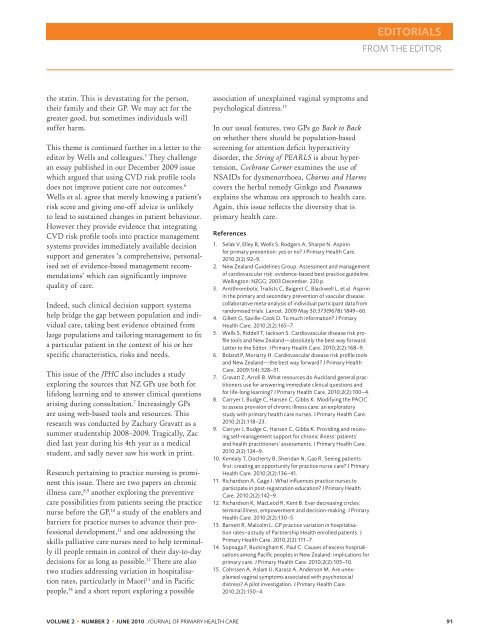entire issue - The Royal New Zealand College of General Practitioners
entire issue - The Royal New Zealand College of General Practitioners
entire issue - The Royal New Zealand College of General Practitioners
Create successful ePaper yourself
Turn your PDF publications into a flip-book with our unique Google optimized e-Paper software.
EDITORIALs<br />
from the editor<br />
the statin. This is devastating for the person,<br />
their family and their GP. We may act for the<br />
greater good, but sometimes individuals will<br />
suffer harm.<br />
This theme is continued further in a letter to the<br />
editor by Wells and colleagues. 5 <strong>The</strong>y challenge<br />
an essay published in our December 2009 <strong>issue</strong><br />
which argued that using CVD risk pr<strong>of</strong>ile tools<br />
does not improve patient care nor outcomes. 6<br />
Wells et al. agree that merely knowing a patient’s<br />
risk score and giving one-<strong>of</strong>f advice is unlikely<br />
to lead to sustained changes in patient behaviour.<br />
However they provide evidence that integrating<br />
CVD risk pr<strong>of</strong>ile tools into practice management<br />
systems provides immediately available decision<br />
support and generates ‘a comprehensive, personalised<br />
set <strong>of</strong> evidence-based management recommendations’<br />
which can significantly improve<br />
quality <strong>of</strong> care.<br />
Indeed, such clinical decision support systems<br />
help bridge the gap between population and individual<br />
care, taking best evidence obtained from<br />
large populations and tailoring management to fit<br />
a particular patient in the context <strong>of</strong> his or her<br />
specific characteristics, risks and needs.<br />
This <strong>issue</strong> <strong>of</strong> the JPHC also includes a study<br />
exploring the sources that NZ GPs use both for<br />
lifelong learning and to answer clinical questions<br />
arising during consultation. 7 Increasingly GPs<br />
are using web-based tools and resources. This<br />
research was conducted by Zachary Gravatt as a<br />
summer studentship 2008–2009. Tragically, Zac<br />
died last year during his 4th year as a medical<br />
student, and sadly never saw his work in print.<br />
Research pertaining to practice nursing is prominent<br />
this <strong>issue</strong>. <strong>The</strong>re are two papers on chronic<br />
illness care, 8,9 another exploring the preventive<br />
care possibilities from patients seeing the practice<br />
nurse before the GP, 10 a study <strong>of</strong> the enablers and<br />
barriers for practice nurses to advance their pr<strong>of</strong>essional<br />
development, 11 and one addressing the<br />
skills palliative care nurses need to help terminally<br />
ill people remain in control <strong>of</strong> their day-to-day<br />
decisions for as long as possible. 12 <strong>The</strong>re are also<br />
two studies addressing variation in hospitalisation<br />
rates, particularly in Maori 13 and in Pacific<br />
people, 14 and a short report exploring a possible<br />
association <strong>of</strong> unexplained vaginal symptoms and<br />
psychological distress. 15<br />
In our usual features, two GPs go Back to Back<br />
on whether there should be population-based<br />
screening for attention deficit hyperactivity<br />
disorder, the String <strong>of</strong> PEARLS is about hypertension,<br />
Cochrane Corner examines the use <strong>of</strong><br />
NSAIDs for dysmenorrhoea, Charms and Harms<br />
covers the herbal remedy Ginkgo and Pounamu<br />
explains the whanau ora approach to health care.<br />
Again, this <strong>issue</strong> reflects the diversity that is<br />
primary health care.<br />
References<br />
1. Selak V, Elley R, Wells S, Rodgers A, Sharpe N. Aspirin<br />
for primary prevention: yes or no? J Primary Health Care.<br />
2010;2(2):92–9.<br />
2. <strong>New</strong> <strong>Zealand</strong> Guidelines Group. Assessment and management<br />
<strong>of</strong> cardiovascular risk: evidence-based best practice guideline.<br />
Wellington: NZGG; 2003 December. 220 p.<br />
3. Antithrombotic Trialists C, Baigent C, Blackwell L, et al. Aspirin<br />
in the primary and secondary prevention <strong>of</strong> vascular disease:<br />
collaborative meta-analysis <strong>of</strong> individual participant data from<br />
randomised trials. Lancet. 2009 May 30;373(9678):1849–60.<br />
4. Gillett G, Saville-Cook D. To much information? J Primary<br />
Health Care. 2010;2(2):165–7.<br />
5. Wells S, Riddell T, Jackson S. Cardiovascular disease risk pr<strong>of</strong>ile<br />
tools and <strong>New</strong> <strong>Zealand</strong>—absolutely the best way forward.<br />
Letter to the Editor. J Primary Health Care. 2010;2(2):168–9.<br />
6. Boland P, Moriarty H. Cardiovascular disease risk pr<strong>of</strong>ile tools<br />
and <strong>New</strong> <strong>Zealand</strong>—the best way forward? J Primary Health<br />
Care. 2009;1(4):328–31.<br />
7. Gravatt Z, Arroll B. What resources do Auckland general practitioners<br />
use for answering immediate clinical questions and<br />
for life-long learning? J Primary Health Care. 2010;2(2):100–4.<br />
8. Carryer J, Budge C, Hansen C, Gibbs K. Modifying the PACIC<br />
to assess provision <strong>of</strong> chronic illness care: an exploratory<br />
study with primary health care nurses. J Primary Health Care.<br />
2010;2(2):118–23.<br />
9. Carryer J, Budge C, Hansen C, Gibbs K. Providing and receiving<br />
self-management support for chronic illness: patients’<br />
and health practitioners’ assessments. J Primary Health Care.<br />
2010;2(2):124–9.<br />
10. Kenealy T, Docherty B, Sheridan N, Gao R. Seeing patients<br />
first: creating an opportunity for practice nurse care? J Primary<br />
Health Care. 2010;2(2):136–41.<br />
11. Richardson A, Gage J. What influences practice nurses to<br />
participate in post-registration education? J Primary Health<br />
Care. 2010;2(2):142–9.<br />
12. Richardson K, MacLeod R, Kent B. Ever decreasing circles:<br />
terminal illness, empowerment and decision-making. J Primary<br />
Health Care. 2010;2(2):130–5.<br />
13. Barnett R, Malcolm L. GP practice variation in hospitalisation<br />
rates–a study <strong>of</strong> Partnership Health enrolled patients. J<br />
Primary Health Care. 2010;2(2):111–7.<br />
14. Sopoaga F, Buckingham K, Paul C. Causes <strong>of</strong> excess hospitalisations<br />
among Pacific peoples in <strong>New</strong> <strong>Zealand</strong>: implications for<br />
primary care. J Primary Health Care. 2010;2(2):105–10.<br />
15. Cohrssen A, Aslam U, Karasz A, Anderson M. Are unexplained<br />
vaginal symptoms associated with psychosocial<br />
distress? A pilot investigation. J Primary Health Care.<br />
2010;2(2):150–4.<br />
VOLUME 2 • NUMBER 2 • JUNE 2010 J OURNAL OF PRIMARY HEALTH CARE 91

















